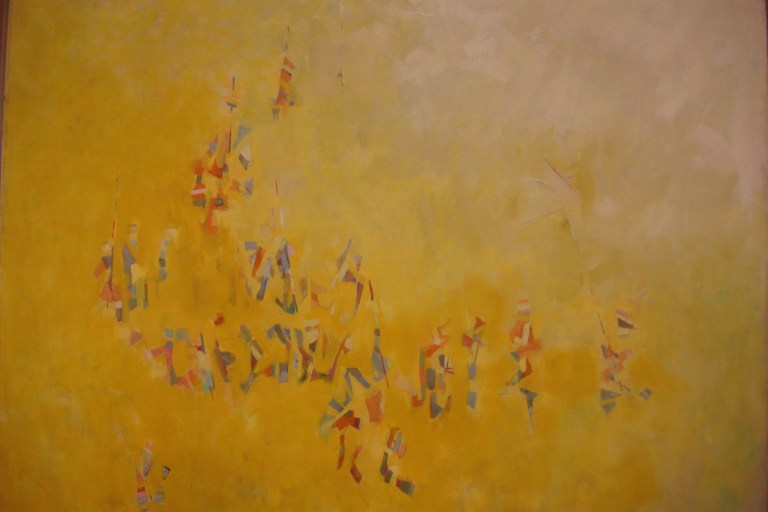Norman Lewis, 1909-1979, American
From an exhibition in 2016 at the Pennsylvania Academy of the Fine Arts, Philadelphia.
Norman Lewis, a New Yorker, an Abstract Expressionist of the first hour, was a Bermudan by descent.

Norman Lewis. I do not have a date.
Born in Harlem, his work expressed the life of Harlemites among whom he lived,
his interest in the natural world,
his effort to reconcile a representation of the social conflict of his time with his aesthetic values,
and his interest in humans gathering for ritual, festival, shopping, and political action.
He started painting in his mid-20s from an intense interest in art after years of other kinds of work and wartime service.
He was trained in many kinds of needlework when he was young and trying to make a living. He made clothes and continued to do so most of his life.
His interest in colours and patterns and stuff is obvious.

Self-portrait by Norman Lewis, 1940; oil on paper. Photo from the net.
For twelve or fourteen years, his work was figurative.

Two Women Reading; and detail; oil on canvas; 1940

TBD

Police Beating (Untitled), 1943; ink, graphite, watercolor on paper.

Hep Cats, 1943, oil on canvas. Private collection on loan to the Pennsylvania Academy of Fine Arts in 2015/16


Meeting Place aka Shopping; and details; 1941; oil on canvas.

Potato eaters; 1945; oil on canvas (Hard Times)
 Fish Eaters; 1944; ink and watercolor on paper (Hard Times)
Fish Eaters; 1944; ink and watercolor on paper (Hard Times)
Title Unknown (Man with Yellow Hands); 1946; oil on canvas.


TBD
Norman Lewis began to paint using abstract forms as soon as he saw the movement born.
It was 1944 or ’45 when he began to display a mature experimentation in abstract forms without, it seems, going through an immaturity.
His work has been underappreciated. Because he is black and not because his work was not known to other New York artists, some of whom were friends.
Racism in the United States has wasted people in every way human beings can be wasted. Because the colour of their skin was something other than white.
Perhaps with the 2019 first acquisition by the Whitney of one of Norman Lewis’ canvases, his work will get more exposure now.
 Composition 1, 1945. Oil on canvas
Composition 1, 1945. Oil on canvas
His abstract paintings with as their subject the life of his community, his observations of nature, ritual, celebration, the life of people together, are passionate, precise and disciplined. They stay with you.
Architectural Abstraction; 1945; oil, watercolour and ink on paper

Phantasy II, 1946, oil on canvas
MOMA, NY
Norman Lewis was active in the fight for the political and economic rights of American blacks. He was co-founder and first president of Spiral. These were black artists in New York who wanted to figure out how to contribute to the Civil Rights movement.

Title Unknown; 1946; oil on canvas


The Messenger, 1952, charcoal and ink on paper.
MOMA, NY
Lewis struggled with how to infuse his aesthetics with the politics of the day and finally separated the practice of the two.
One could interpret this negatively as a comment on the artist’s view of black life as being devoid of aesthetic qualities. But we know, from his paintings and his life, that this was not true. One would say that Lewis fought in his life for equality and drew nourishment from his art and that this nourishment was not fed by poisonous wells.


Countless Upward; and detail; 1959; crayon, ink and watercolour on paper
Many of Norman Lewis’ paintings were not titled.
I imagine that this is related to the fact that his work was not shown as much (Betty Parsons!) nor bought as much as that of his peers, many of whom he knew. And that he did not think much about titles because he himself did not need titles for his work.

Birds; 1950; oil on canvas
Most striking is the variety of forms and patterns used; the fearless colors. Even more striking than this is a pattern-making which shows layers: the reality behind what appears; or images which appear intermittently in a field of something else; or two realities which live fluidly with each other.

France-terrace; oil on paper; 1960
A wonderful and heartening body of work by a man not born to art but who invoked his vocation despite the odds.
Untitled, oil and pastel on paper; 1964
Nor did he reap the rewards earned by several of his peers, members of the majority population now in a pantheon from which they will never be dislodged.
Which Norman Lewis has joined, in my mind.

detail of Night Walk; oil on canvas; 1956

Title unknown (Procession); 1949; oil on canvas

Congregation; 1950; watercolour, crayon and ink on coated fiberboard


The Messenger, 1962, charcoal and ink on paper. MOMA, NY

Winter branches; ink on paper; 1956

detail of Rhododendrons in winter; 1948; oil on canvas
America the Beautiful, oil paint on canvas, 1960.
Norman Lewis, 1909-1979, American. Private collection on loan to the Brooklyn Museum in 2018/19.
The Klu Klux Klan dressed up, carrying the crosses of their hate, on the move at night.

Carnivale del Sol; oil on canvas; 1962

Carnivale II, 1962; oil on canvas

American Totem (Klu Klux Klan); 1960; oil on paper.
Acquired by the Whitney Musuem of (North) American art in February 2019 with an appreciation of how underappreciated Norman Lewis is.

Alabama; 1960; oil on canvas

Title unknown (Alabama); 1967; oil on canvas. National Gallery of Art, Washington, DC
Lewis’ black-and-white paintings are about race. The one immediately above is and is not a weapon.

Title unknown (March on Washington); 1965; oil on fiberboard


Confrontation; and detail; 1971; oil on canvas


Triumphal; and detail; 1972; oil on canvas

Parade of Figures, 1972, etching
Metropolitan Museum of Art, NY

Sea Change, oil on canvas, 1975. Private collection.








